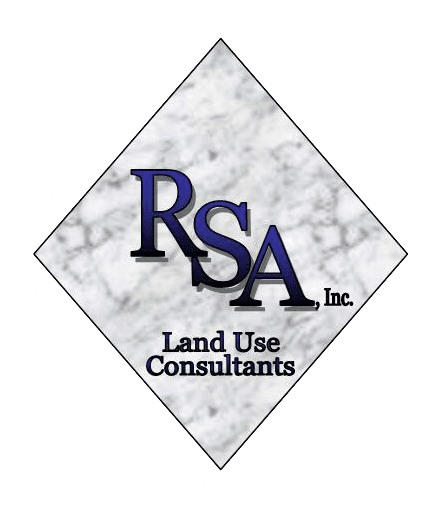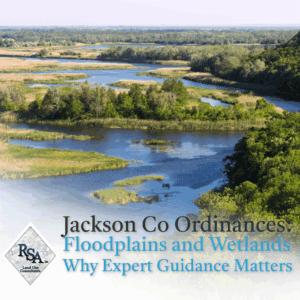When purchasing or developing property in Southern Oregon, it’s easy to get excited about the possibilities—expansive views, fertile land, or prime development opportunities. But beneath the surface of every transaction lies a critical set of land use rules that can make or break your plans: local ordinances governing floodplains and wetlands, outlined in Chapter 7 of the Jackson County Land Development Ordinance. These rules are not only complex, but they also carry significant consequences if misunderstood. That’s why turning to experts like Richard Stevens & Associates before making any commitments is one of the smartest decisions you can make.
 What Are Floodplains and Wetlands?
What Are Floodplains and Wetlands?
Floodplains are low-lying areas adjacent to rivers, streams, and creeks that naturally absorb floodwaters during heavy rains. Wetlands are areas where water saturates the soil either seasonally or year-round, creating unique ecosystems and providing natural flood protection. Both are vital environmental resources that Jackson County, like most counties in Oregon, regulates carefully to protect public safety, private property, and ecological health.
While these areas can be beautiful and even desirable for certain uses, they come with restrictions. Building, grading, or altering land within floodplains or wetlands often requires permits, engineering studies, and compliance with state and federal standards in addition to county rules.
Jackson County’s Ordinances in Chapter 7
Chapter 7 of the Jackson County Land Development Ordinance lays out detailed standards for development in special-purpose districts, including Floodplain Overlay Districts and Wetland Protection areas. Key takeaways include:
- Floodplain management requirements that align with federal flood insurance standards often mean elevating or floodproofing structures within designated flood hazard zones.
- Setback and buffer zones near wetlands or riparian corridors to protect water quality, wildlife, and natural drainage.
- Permitting thresholds where even small projects—like sheds, driveways, or ponds—may trigger review if they occur in sensitive areas, with limited possibilities for variances.
- Mapping and delineation needs where county and federal maps identify general boundaries, but on-site professional evaluation is often required because conditions can shift over time.
In other words, what looks like a clear, dry piece of land in August might legally be part of a floodplain or a regulated wetland when county rules and state definitions are applied.
Why It Matters for Property Buyers and Developers
The stakes are high. Purchasing land without understanding floodplain or wetland restrictions can lead to unexpected costs, stalled projects, or even unusable property. For example:
- A planned home site may need expensive elevation or floodproofing measures.
- A commercial development could be delayed for months while wetland delineations are performed and permits are secured.
- Insurance costs may climb if structures fall within flood hazard zones.
- A dream project could become unfeasible if the county denies approval.
These scenarios are not rare—they are common pitfalls for buyers and developers who proceed without expert guidance.
The Role of Professional Guidance
This is where Richard Stevens & Associates comes in. With decades of experience navigating Jackson County’s ordinances and state and federal land use laws, the team provides critical expertise to help you make informed decisions and avoid costly missteps.
- Evaluate the property before you buy. A professional review ensures you understand whether floodplains or wetlands affect the property—and what that means for your intended use.
- Interpret ordinances and regulations. Chapter 7 may read like a foreign language, but experts can translate legal and technical jargon into clear guidance tailored to your project.
- Coordinate with agencies. Compliance may involve Jackson County, the Oregon Department of State Lands, the U.S. Army Corps of Engineers, or FEMA. Navigating this web of agencies requires skill and persistence.
- Plan for success. By identifying constraints early, you can shape realistic development plans, avoid unnecessary delays, and budget effectively.
A Proactive Approach Saves Time and Money
Many property owners seek help only after encountering a problem—an application rejection, a stop-work order, or an unexpected floodplain designation. By that point, the process is more expensive, stressful, and time-consuming.
Engaging Richard Stevens & Associates early turns potential roadblocks into manageable challenges. A proactive approach helps you anticipate requirements, minimize surprises, and ultimately achieve your goals without costly detours.
Protecting More Than Just Your Investment
Beyond personal financial stakes, understanding and complying with floodplain and wetland rules protects the broader Southern Oregon community. These areas are natural safety buffers during extreme weather, reducing flood damage for neighborhoods and preserving ecosystems that support fish, birds, and wildlife. Responsible development ensures that growth in Jackson County is sustainable and resilient for future generations.
Don’t Go It Alone – Contact Richard Stevens and Associates
Floodplains and wetlands are more than features on a map—they are heavily regulated areas that require careful planning and expert interpretation. Jackson County Land Development Ordinances are designed to protect property owners and the environment, but they can also complicate even the simplest projects.
Before buying, building, or breaking ground in Southern Oregon, ensure you fully understand the rules. Contact Richard Stevens & Associates (rsaoregon.com) for trusted guidance through Jackson County’s land use process. Their experience, insight, and dedication will help you avoid pitfalls and move your project forward with confidence.

 What Are Floodplains and Wetlands?
What Are Floodplains and Wetlands?